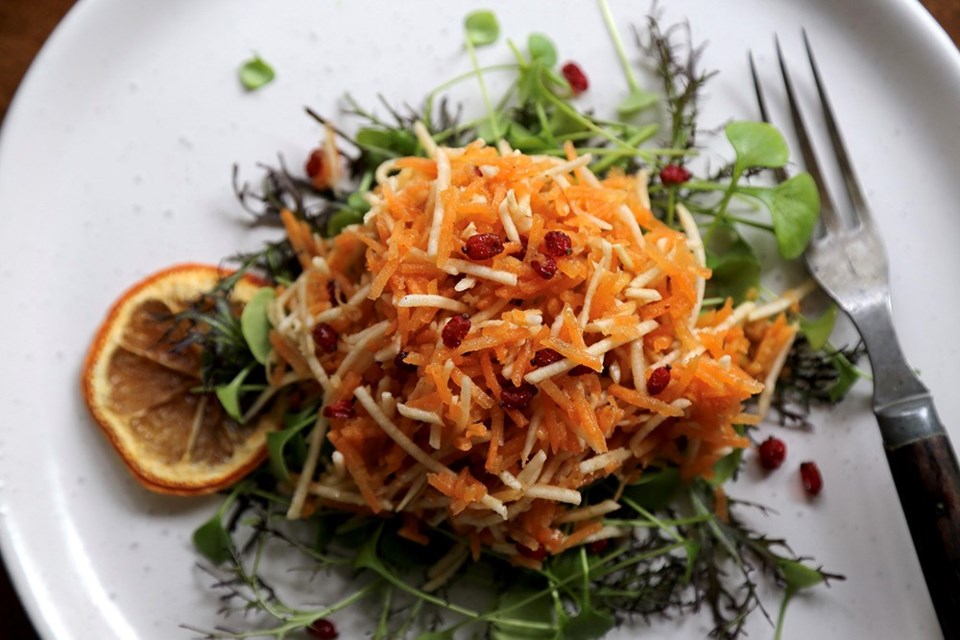After the crazy cold "snap" that fell bracingly between alternating flights of wet snow and deep snow, I pretty much gave up attempting to lift the frozen-shut lids of the cold frames, or trying to sweep heavy blankets of snow off of the hooped and fleeced beds.
Ultimately, I conceded defeat and let nature do what she wanted so badly to do. More lessons in the making from a wounded planet.
Heavy row cover, as it turns out, might be better at fending off frost, but it doesn’t carry its weight nearly as effectively during wet snow events as does more permeable light row cover. Who would have thought? In the end, about half of the brassicas were broken by avalanche when my high hoops caved in.
Just this week, I was able to get out into a snow-free food garden and assess damage done during the past several weeks. Not surprisingly, our beds look very different this January than they did last. I am surprised and delighted that, after extended periods of -10°C to -15°C, extreme freeze-thaw cycles, abject saturation, and freezing cold winds, all was not lost in the stand-alone beds.
Tender varieties of spinach, cutting celery, and the outer leaves of some chicory, radicchio and endive packed it in, but pretty much everything else under cold-frame cover fought the good fight, if bedraggled. Unless something drastic happens, I am expecting good things after mid-February or so, once daylight hours increase enough to kick-start growth again.
I had neglected some potted kales and frilly mustard inside the cold frames, and assumed of course that they would die from exposure. Miraculously, they made it through, I suppose because their potted soil stayed quite dry relative to the sodden surface soil upon which they sat. Note taken. Lesson learned.
Inside our tiny old glasshouse, I’d set a greenhouse heater to keep the temperature at just 1°C, as an experiment to see how long I could keep some remnant lettuce and beets alive. They were planted from seed on Aug. 16, but not all made it into the gardens. Unbelievably, the feisty runts are still with us. I am gobsmacked by the resilience and determination of living things. This gives me hope and inspiration for not merely coping, but thriving during extreme winters and extreme summers in the not too distant future.
What I envision eventually, as an addition to my urban food gardens, is a climate change-friendly, custom designed indoor-outdoor flex space that is as resilient as nature, and that can respond to extremes as needed, to mitigate distress and ensure success during what is sure to be an extended period of adjustment.
I declare this as if it is an ideal, rather than a necessity born of losing battles that I cannot anticipate as climate change radically upsets natural balances in predators, pollinators, temperature, rainfall, humidity, wind, even sunlight and air quality.
The good news is that solutions can and will be found. We have been inspired to respond en masse, and to innovate as if our lives depend on it. Technology, open-source information sharing, and advances in renewable energy and energy storage, coupled with ancient and traditional wisdom, are enabling exciting ways and means of growing food in the most extreme climates, and in food deserts.
Permaculture has taught me that, sometimes giving in, sitting back and taking notes is more important than fighting back. By conceding defeat, and then observing patiently, I have learned valuable lessons that will serve our gardens well.
For now, I am celebrating small victories with a Persian-inspired winter carrot and celeriac salad with barberries, sour orange, black lime, pomegranate molasses and toasted pistachio. I am nearing the end of my annual stores of frozen sour orange juice cubes, and dehydrated sour orange slices, but thankfully citrus season is upon us.
The carrots and celeriac, rendered impossibly sweet and delicious by the cold, were gifts from our resilient winter garden.
Persian-Spiced Carrot & Celeriac Salad
For dressing: combine 1/4 cup each olive oil and sour orange juice*, 1 tsp. lime powder*, 1 Tbsp. pomegranate molasses*, pinch each 7-spice* and sea salt.
For salad: combine 2 cups each grated carrot and celeriac with 2 Tbsp. barberries and 2 Tbsp. toasted pistachios. Dress lightly. Serves 4.
*available at Persian markets
Laura Marie Neubert is a West Vancouver-based urban permaculture designer. Follow her on Instagram @upfrontandbeautiful, learn more about permaculture by visiting her Upfront & Beautiful website or email your questions to her here.
For a taste of permaculture, click on the YouTube link below:
(Video - Courtesy of West Vancouver Memorial Library)



